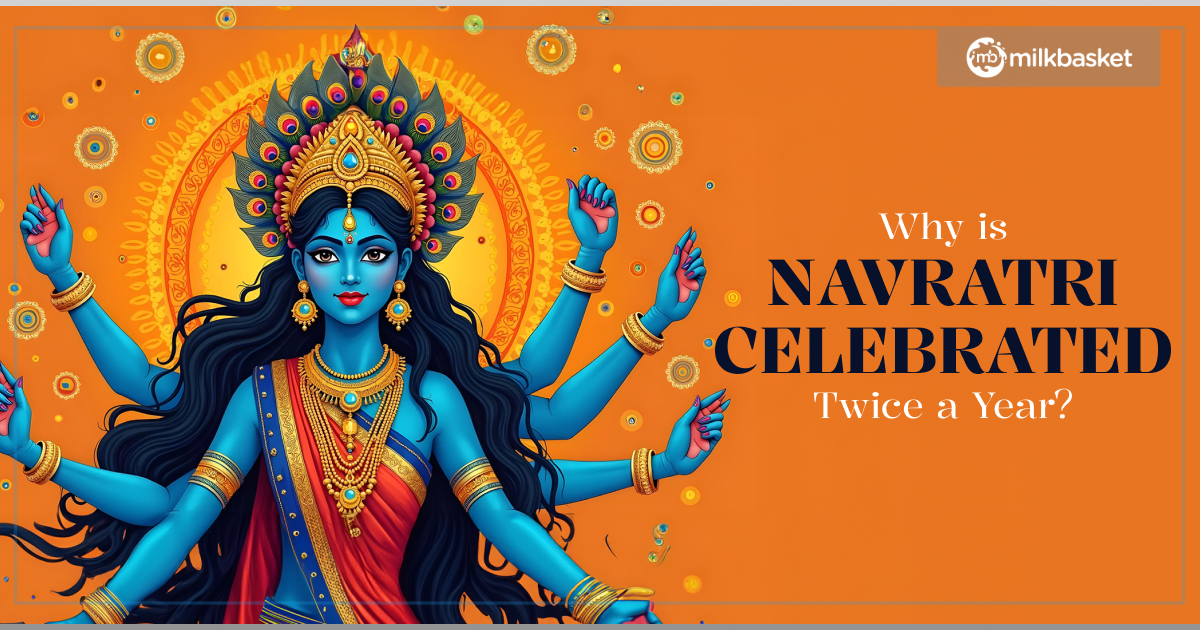Why is Navratri Celebrated Twice a Year?
Navratri, one of the most significant Hindu festivals, is celebrated with a lot of enthusiasm not just in India, but across the world by Hindu communities. What makes Navratri unique is that it’s observed twice a year—once during Chaitra Navratri and again during Sharad or Shardiya Navratri, both dedicated to the goddess Durga.
Each celebration carries its own cultural significance, rituals, and traditions. In this blog, we’ll explore why Navratri is celebrated twice a year, what sets Chaitra Navratri apart from Shardiya Navratri, and the overall importance of these two festivals.
What are the Two Navratri?
‘Navratri’ literally means ‘nine nights,’ and during these nine nights, people worship the divine feminine energy, also known as the goddess Durga. But why two Navratris? Let’s break it down:
Chaitra Navratri
- When: Happens in March or April, during the Hindu month of Chaitra.
- What it signifies: Chaitra Navratri marks the arrival of spring. It’s considered a time for renewal and new beginnings.
- What’s special: During these nine days, people worship the goddess Durga in her various forms—like Shailputri, Brahmacharini, and Chandraghanta—each representing different virtues and powers.
Unique Facts About Chaitra Navratri:
- New Year for Some Communities: Chaitra Navratri marks the beginning of the Hindu calendar year for several communities, including those in Maharashtra (Gudi Padwa) and Karnataka (Ugadi).
- Ram Navami: The festival culminates with Ram Navami, celebrating the birth of Lord Rama, adding extra significance to the final day of Chaitra Navratri.
- Simpler Celebrations: Compared to Sharad Navratri, the rituals during Chaitra Navratri are more personal and focused on fasting, meditation, and home-based pujas rather than large public festivities.
- Agricultural Significance: Farmers often consider Chaitra Navratri an auspicious time to start new planting, as it coincides with the start of the summer crop season.
- Connection with Nature: Since it occurs in spring, many rituals and customs during Chaitra Navratri are tied to renewal and the rejuvenation of life and nature.
Sharad Navratri:
- When: Celebrated in September or October, during the Hindu month of Ashwin.
- What it signifies: Sharad or Shardiya Navratri coincides with the harvest season and is a much bigger festival in terms of scale and celebration.
- What’s special: This Navratri is celebrated with grand cultural events, music, and dances like Garba and Dandiya, especially in Gujarat. It ends with Dussehra, marking Lord Rama’s victory over Ravana, symbolizing the triumph of good over evil.
Unique Facts About Sharad Navratri:
- Nine-Day Dance Festival: In states like Gujarat, Shardiya Navratri is synonymous with Garba and Dandiya Raas, where people gather for nine consecutive nights of dance, celebrating the goddess with joy and enthusiasm.
- Durga Puja in West Bengal: While Sharad or Shardiya Navratri is celebrated across India, in West Bengal, it overlaps with Durga Puja, one of the grandest festivals in the region, with massive statues of Durga and elaborate pandals.
- Mythological Importance: This Navratri is linked to the battle between Goddess Durga and Mahishasura, symbolizing the victory of good over evil, making it more focused on mythological stories compared to Chaitra Navratri.
- Dussehra Connection: Sharad Navratri ends with Dussehra (Vijayadashami), celebrating Lord Rama’s victory over Ravana. In many parts of India, effigies of Ravana are burnt to signify the destruction of evil.
- Larger-Scale Festivities: Sharad or Shardiya Navratri involves more public events and is celebrated with grander processions, large-scale Durga pujas, and cultural performances. It’s considered more of a community event, especially in northern and western India.
Difference Between Chaitra Navratri vs. Sharad Navratri
While both versions of Navratri share the theme of goddess Durga worship, there are some key differences between Chaitra Navratri and Sharad Navratri:
- Timing and Seasons: Chaitra Navratri happens in spring, while Sharad or Sharadiya Navratri falls in autumn. This seasonal difference brings unique elements to each celebration.
- Rituals: Chaitra Navratri tends to be quieter and more focused on prayer and fasting. On the other hand, Sharad Navratri is all about grand festivities with more elaborate rituals.
- Significance: Chaitra Navratri is linked with the arrival of spring and nature’s rejuvenation. Shardiya Navratri, however, is deeply connected with the victory of good over evil, particularly through mythological stories like Goddess Durga’s battle with Mahishasura and Lord Rama’s victory over Ravana.
How Many Times is Navratri Celebrated in a Year?
In a typical year, Navratri is celebrated twice—Chaitra Navratri in the spring and Shardiya Navratri in the autumn. However, some regions also celebrate a lesser-known Magha Navratri in January or February.
While it’s not as widely observed, it still holds spiritual significance for those who practice it.
Final Thoughts
Navratri isn’t just about devotion, it’s also a celebration of life’s cyclical nature. Celebrating it twice a year gives devotees the chance to connect with the divine feminine energy in different ways.
Whether through the peaceful prayers of Chaitra Navratri or the vibrant dances of Sharad or Shardiya Navratri.
By understanding the unique elements of each Navratri, you can appreciate the deeper meaning behind this festival and how it unites millions in worship and celebration across the globe.
If you’re looking for Shardiya Navratri essential puja item, look no further than Milkbasket – best online grocery shopping app. You can find 9000+ items from fruits, vegetables, hygein item to daily essential items.
Just download the app, choose your required product, and add or modify your cart by 12 AM and voila! We’ll deliver your items by 7 AM – all silently! 
Categories
Popular Posts
-

Milkbasket – A Revolution In The Online Grocery Delivery Services In India
Spread the loveThere’s no denying the fact that the pandemic has drastically changed the way people spend their time online, buying everything through various online retail platforms with the convenience of home deliveries in India. Milkbasket, with it’s features has proven to be a revolution in the online grocery delivery services in India. While stepping […]
08 Jul 2022 read More... -

Milkbasket’s Latest DVC Campaign Is Out, And It’s Quirky And Relatable As Heck!
Spread the loveThe year 2021 was all about patience, resilience, and the grind it takes to get back up from a worldwide slump that the COVID-19 pandemic had hit us with. It made us all revisit our roots, recalibrate our priorities, and strengthen our foundations. With the better part of 2022 gone into slowly spreading […]
28 Sep 2022 read More... -

Nabhi Chikitsa or Belly Button Therapy: The Simple Health Secret You NEED To Know!
Spread the loveOur Navel or Belly Button (scientific name Umbilicus) is believed to be the centre of our life force. Most of us take it as just another part of our body not knowing its deep, thrilling world. In ancient Hindu healing practices, the Navel is considered to be the most important point of the […]
08 Sep 2022 read More... -

Your Trustworthy Guide To The Best Coffee Brands In India You Can Try
Spread the loveIf you’re a coffee lover, you know that coffee isn’t just a beverage. It’s a feeling, a good feeling. No, it’s a great feeling! One of the best feelings, in fact. Many songs and poems have been written to romanticize this delicious and invigorating drink. Although coffee in any form or recipe tastes […]
12 Aug 2022 read More...

